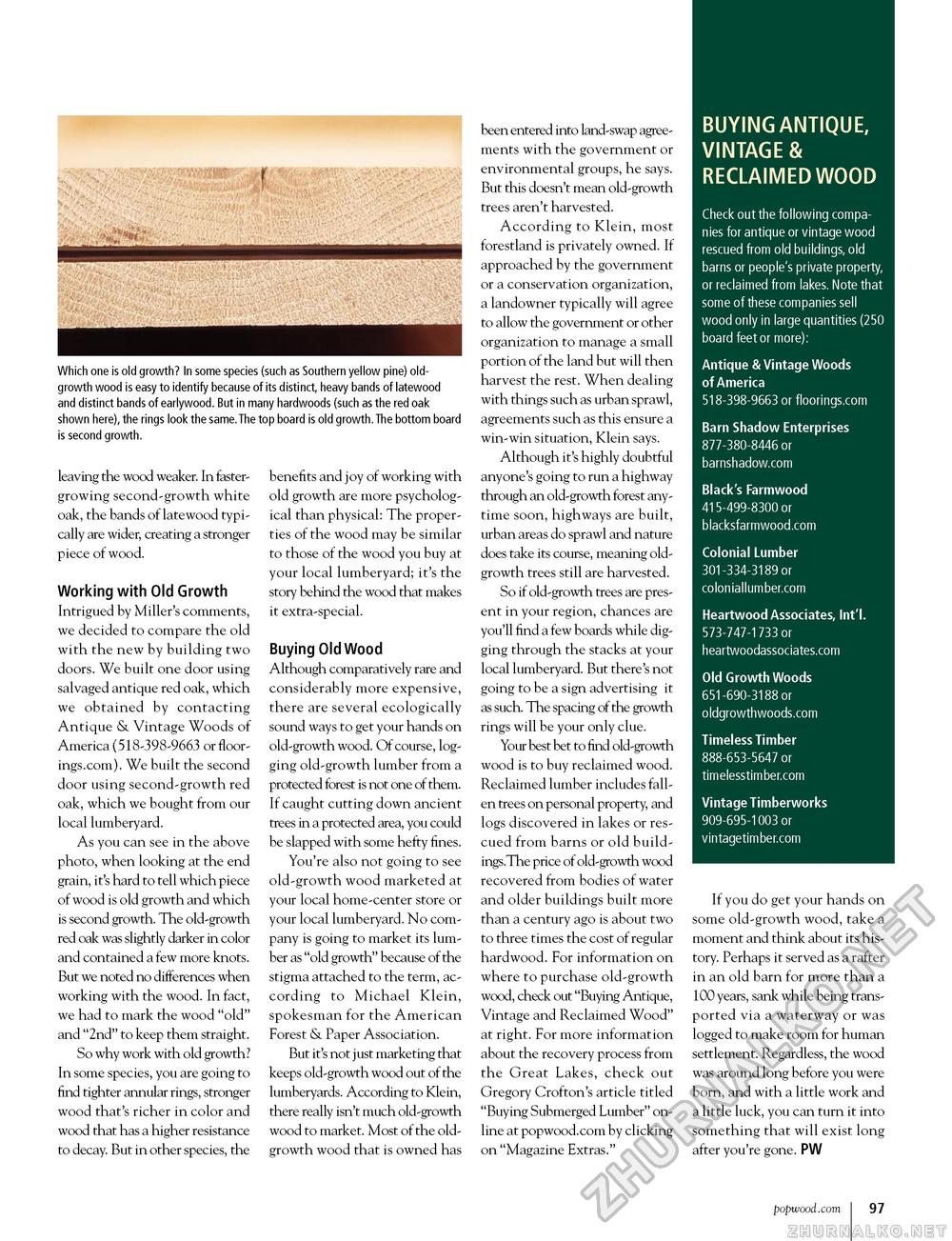Popular Woodworking 2003-12 № 138, страница 96
BUYING ANTIQUE, VINTAGE & RECLAIMED WOOD Check out the following companies for antique or vintage wood rescued from old buildings, old barns or people's private property, or reclaimed from lakes. Note that some of these companies sell wood only in large quantities (250 board feet or more): Antique & Vintage Woods of America 518-398-9663 or floorings.com Barn Shadow Enterprises 877-380-8446 or barnshadow.com Black's Farmwood 415-499-8300 or blacksfarmwood.com Colonial Lumber 301-334-3189 or coloniallumber.com Heartwood Associates, Int'l. 573-747-1733 or heartwoodassociates.com Old Growth Woods 651-690-3188 or oldgrowthwoods.com Timeless Timber 888-653-5647 or timelesstimber.com Vintage Timberworks 909-695-1003 or vintagetimber.com Which one is old growth? In some species (such as Southern yellow pine) old-growth wood is easy to identify because of its distinct, heavy bands of latewood and distinct bands of earlywood. But in many hardwoods (such as the red oak shown here), the rings look the same.The top board is old growth.The bottom board is second growth. leaving the wood weaker. In faster-growing second-growth white oak, the bands of latewood typically are wider, creating a stronger piece of wood. Working with Old Growth Intrigued by Miller's comments, we decided to compare the old with the new by building two doors. We built one door using salvaged antique red oak, which we obtained by contacting Antique & Vintage Woods of America (518-398-9663 or floor-ings.com). We built the second door using second-growth red oak, which we bought from our local lumberyard. As you can see in the above photo, when looking at the end grain, it's hard to tell which piece of wood is old growth and which is second growth. The old-growth red oak was slightly darker in color and contained a few more knots. But we noted no differences when working with the wood. In fact, we had to mark the wood "old" and "2nd" to keep them straight. So why work with old growth? In some species, you are going to find tighter annular rings, stronger wood that's richer in color and wood that has a higher resistance to decay. But in other species, the benefits and joy of working with old growth are more psychological than physical: The properties of the wood may be similar to those of the wood you buy at your local lumberyard; it's the story behind the wood that makes it extra-special. Buying Old Wood Although comparatively rare and considerably more expensive, there are several ecologically sound ways to get your hands on old-growth wood. Of course, logging old-growth lumber from a protected forest is not one of them. If caught cutting down ancient trees in a protected area, you could be slapped with some hefty fines. You're also not going to see old-growth wood marketed at your local home-center store or your local lumberyard. No company is going to market its lumber as "old growth" because of the stigma attached to the term, according to Michael Klein, spokesman for the American Forest & Paper Association. But it's not just marketing that keeps old-growth wood out of the lumberyards. According to Klein, there really isn't much old-growth wood to market. Most of the old-growth wood that is owned has been entered into land-swap agreements with the government or environmental groups, he says. But this doesn't mean old-growth trees aren't harvested. According to Klein, most forestland is privately owned. If approached by the government or a conservation organization, a landowner typically will agree to allow the government or other organization to manage a small portion of the land but will then harvest the rest. When dealing with things such as urban sprawl, agreements such as this ensure a win-win situation, Klein says. Although it's highly doubtful anyone's going to run a highway through an old-growth forest anytime soon, highways are built, urban areas do sprawl and nature does take its course, meaning old-growth trees still are harvested. So if old-growth trees are present in your region, chances are you'll find a few boards while digging through the stacks at your local lumberyard. But there's not going to be a sign advertising it as such. The spacing of the growth rings will be your only clue. Your best bet to find old-growth wood is to buy reclaimed wood. Reclaimed lumber includes fallen trees on personal property, and logs discovered in lakes or rescued from barns or old build-ings.The price of old-growth wood recovered from bodies of water and older buildings built more than a century ago is about two to three times the cost of regular hardwood. For information on where to purchase old-growth wood, check out "Buying Antique, Vintage and Reclaimed Wood" at right. For more information about the recovery process from the Great Lakes, check out Gregory Crofton's article titled "Buying Submerged Lumber" online at popwood.com by clicking on "Magazine Extras." If you do get your hands on some old-growth wood, take a moment and think about its history. Perhaps it served as a rafter in an old barn for more than a 100 years, sank while being transported via a waterway or was logged to make room for human settlement. Regardless, the wood was around long before you were born, and with a little work and a little luck, you can turn it into something that will exist long after you're gone. PW popwood.com 109 |








